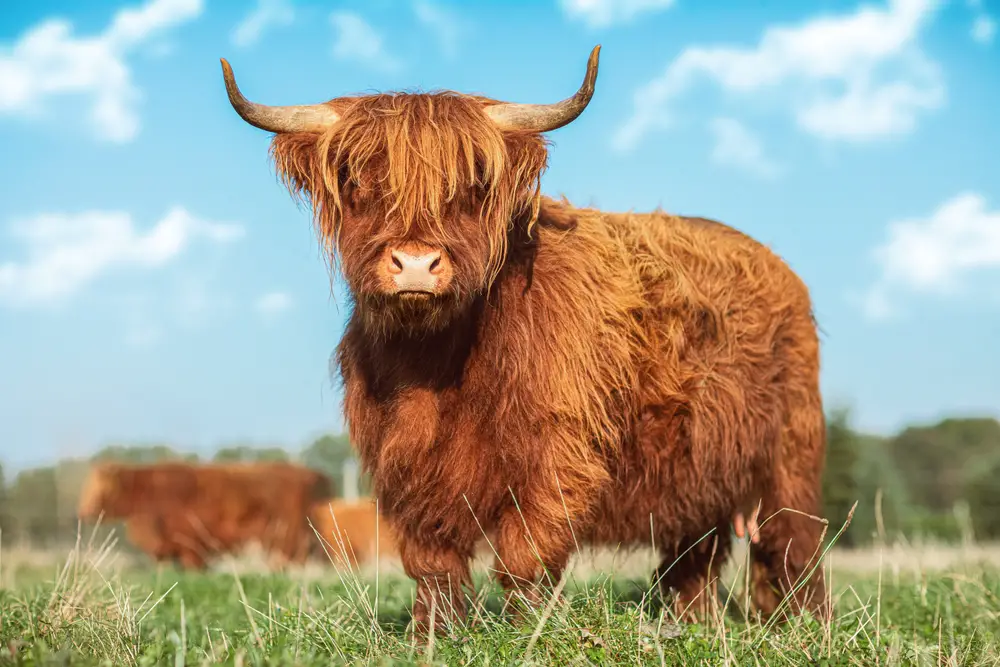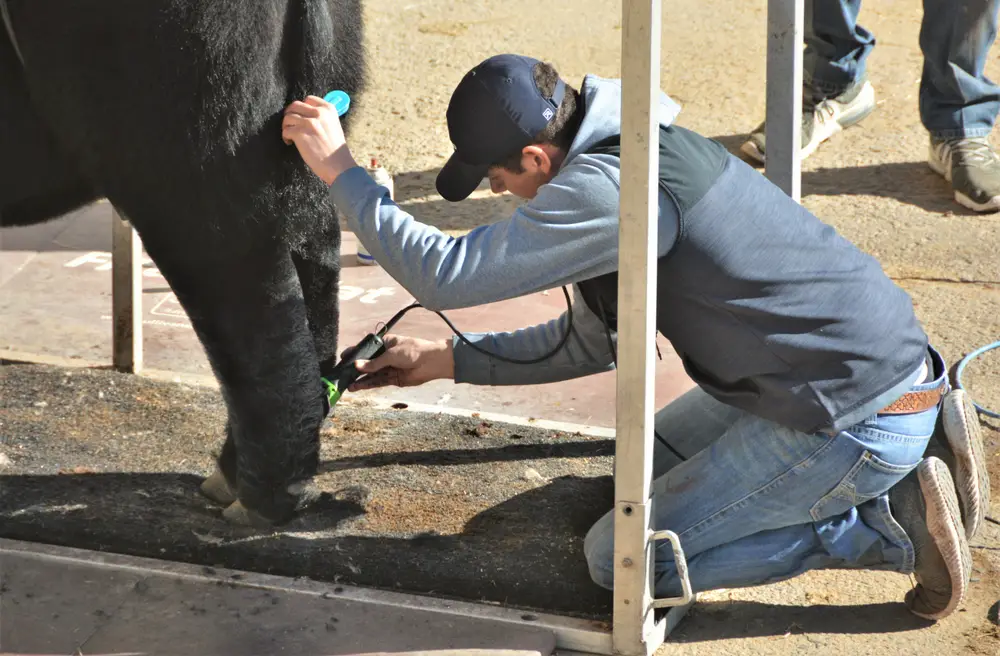Blow-dried cows are simply normal cows that have been pampered and pimped by a farmer to make their hair coat more appealing in cattle shows. They're also called furry cows, fluffy cows, or club calves (baby fluffy cows), with Highland cattle being a popular cattle show breed.
It’s not every day that you see a cow cleaned up and looking cute from pampering and pimping as if she was a tiny, adorable kitten or puppy. You’ll most likely see a cute puppy more than a fluffy cow any day. And what’s a fluffy cow in the first place, anyway? Let’s find out!
Table of Contents
What Are Blow Dried Cows?
Also called furry cows, fluffy cows, or club calves (baby fluffy cows), blow-dried cows are simply regular cows that have been cleaned for cattle shows. They are also called fluffy milk horses, and they first became globally popular when the “Iowa fluffy cows” bred by Matt Lautner of Lautner Farms went viral on social media as people shared their cute pictures and memes.
The term ‘fluffy cows’ is traditionally explicitly given to Highland cattle as they are always full of fluff all-year round and are known as the cows with the longest hair. The use of the name to refer to blow-dried cattle became more common when Matt opened the Fluffy Cows Facebook page when his cows went viral.
A blow-dried cow isn’t a special bovine that comes with long hair, at least not necessarily, but just a well-groomed bovine that has been cleaned and polished through a series of painstaking efforts to make them beautiful.


Blow-dried cows, or fluffy cows, as they are more commonly known across the Internet, are usually males. Since the name “cows” is more desirable for any moo-sounding animal, it’s used because it resonates with people more.
A fluffy cow may, thus, be a bull/steer (male) or a heifer/dairy cow (female).
Show steers and heifers are usually paraded in the showing ring at regional and state fairs until they are two years of age, after which they are slaughtered or retired to ordinary on-the-range ranchlife as regular cattle.
How Are Cows Shampoo’d And Blow Dried?
The harmless and restorative process of making a regular cow a fluffy cow is painstaking, often requiring months of daily tender care for the animals through special diets and grooming to maintain both good health and beauty.
Grooming show cattle to look fluffy can happen several times a day, often 1-2 times daily. This prepares them for lots of curious eyes at the show, turning them into cute animals that are halter-broken and well-used to their handler.

The steps involved in making a fluffy cow usually differ from farmer to farmer in chronology, but the following typically happen:
- Shampooing, washing, and rinsing: The cow or bull is washed with warm soapy water to get debris and dust off the hair coat and the body. The bovine aesthetician then rinses the animal with warm water.Fluffy cows may be washed out in the open in warm summer months or inside a suitable structure in the winter when it’s cold.
- Blow drying: Once the cow is clean, she is blow-dried to dry and warm up further.
- Hair combing, brushing, and trimming: Not all hair on the cow will be desirable. Old, broken, and overly long hair is clipped or trimmed (not shaven). The hair coat is also combed or brushed to a desirable conformation on the body.
- Styling: The cow’s hair may be styled using hair spray and oils to condition and make it shiny. A second blowout may be done to achieve a desired hair coat conformation or style.
What Do Farmers Use To Shampoo And Blow Dry Cows?
Farmers and cattle showers use animal-safe products and friendly tools to pamper and pimp their furry bovines without hurting them.
Tools Used To Pamper Fluffy Cows
- Blowers: These are animal-friendly blow driers (larger than human hair blowers) that cover more body surface faster.
- Combs of different sizes and types, usually up to seven different ones per cow!
- A special, cattle-safe squeegee for removing excess water from the cow’s coat.
- Turbo fans for flowing air constantly through the cow’s fur.
- Specialized Roto Fluffer brushes with soft bristles for training animal hair through separation and lifting. They also stimulate hair growth when used daily.
- Electric clippers for trimming hair (not shaving).
- Specialized neoprene neck wrap for making female cattle look more feminine with a firmer neck skin.
- Handheld brushes with soft bristles for use together with combs.
Animal-safe Products Used On Fluffy Cows
- Paintbrush hairs for adding more hair volume, especially on Angus cattle
- Shampoo
- A sweating lotion (used together with the neoprene neck wrap
- Mild soap
- Hair sprays and oils to condition hair and make it shinier and softer
- Hair sheen for nourishing, softening, and strengthening hair to protect it against drying and breaking
- Hoof polish
- Cattle hair dye
- Hair mousse for protecting, taming, and controlling any hair that may curl.
- Baby powder for making some white show cows, such as Charolais, shine brighter.
Why Do Cows Get Shampoo’d And Blow Dried?
Cows basically get shampooed and blow-dried to score good grades in cow shows or livestock exhibitions through programs like the National FFA Organization (formerly Future Farmers of America) and the 4-H.
Farmers showing fluffy cows seek to have their animals impress judges not only for their well-kept hair but also for breeding traits (bulls and heifers) and carcass quality (those about to be slaughtered).
Besides winning showing prizes, farmers and bovine beauticians pimp may pimp fluffy cows for other reasons, such as:
- Selling them off quicker as beef (steers) – yes, some end up as beef—all cute and pampered and proud!
- Selling them off quicker as breeding animals (bulls and heifers)
- Selling them off as pets. Some people buy miniature fluffy cows to raise as pets.
- Petting and cow hugging or cattle cuddling therapy (yes, that’s still a thing!) But not all farmers allow people to pet or hug their fluffy cows.
- “Cow tourism”. People travel far and wide to see the wonder of adorable blow-dried cows. This is accelerated by trending fluffy cows memes, hashtags, and Tiktok videos.
Common Breeds That Are Blow Dried
As mentioned, blow-dried or fluffy cows aren’t a new special breed or only mini cows. They are just pampered and pimped cows prepared for showing in livestock shows.
Although the primary desirable qualification for a fluffy bull or cow is a long hair coat, cattle breeds with naturally short hair coats are also used. This explains why you are likelier to see fluffy cows in winter when most cattle have longer hair and thick coats.
The following breeds are suitable for blow drying:
- Highland cows. These have characteristically long hair that’s ever-adorable and easy to groom. Pimping them makes them even lovelier. Queen Elizabeth II (God bless her soul) had a herd of Scottish Highland cattle at Balmoral Castle, and some of the cows even won at cattle shows!
- Belted Galloway cattle
- Purebred Angus cattle
- Charolais cattle
- (Traditional) Galloway cattle
- South Devon (dense, curly coat)
- Whitebred Shorthorn cattle
- Beef Shorthorn
- British White cattle
- Luing cattle (Crossbreed between Highland cattle for the hair and Beef Shorthorn)
- Welsh Black cattle (thick, fluffy coat in winter)
- Regular Hereford cattle and Miniature Herefords (fluffy winter coat)
- Shetland cattle
- Composite breeds, such as Matt Lautner’s famous Texas Tornado, which is a composite bull of Chianina, Maine Anjou, Shorthorn, and Angus breeds.
